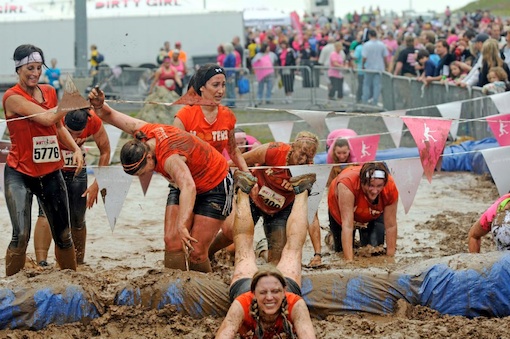“I Need New Knees”
Eighteen months ago, Melissa Davis could barely run. After a lifetime plagued with various knee injuries, Davis, 37, an avid runner, snowboarder and yogi, was told to pack up her trainers. “My running days were officially over,” says the Lehigh Valley resident.
This year, Davis has hit the slopes on her snowboard; completed a mud run, The Color Run, and various other 5Ks; and practiced power yoga almost daily—all with a new set of kneecaps. She has Jess Lonner, a Rothman Institute orthopedic surgeon, to thank for it.
In the first 36 years of her life, Davis’s knees had carried her through eight years of competitive field hockey, across nearly a dozen half- and full-marathon courses, and down countless mountains on her snowboard. She’d been dodging knee surgery since she dislocated her patella throwing the javelin when she was a junior in high school.
“I went to see an orthopedist, and he wanted to operate on me immediately,” Davis says. “He told me that I had very tight IT bands and weak VMOs [the inner portion of the quads], so he wanted to perform a lateral release.”
But, like many young athletes in similar scenarios, Davis held off on the operation: “I was extremely hesitant as I wanted to play field hockey my senior year, and when I did the research on this procedure it was an even split between people who benefitted, people who saw no change, and people who actually felt worse post-op. I did not like those odds, so I opted for a round of physical therapy and wearing a brace,” she says.
Although she had always noticed that her kneecaps were abnormally bony and seemed to rest on the outside of her legs (red flag!), it wasn’t until Davis was bitten by the running bug in college that she decided to get a second opinion. That’s when she met Laura Dunne of Orthopedics Associates of Allentown. For the first time, she found a doctor who gave her the hope she was looking for: that she wouldn’t have to quit running in order to be healthy. “She explained that keeping active actually helps to keep the joints more lubricated and that as long as I could run pain free I should try to do so,” Davis says.
More importantly, Dunne introduced Davis to yoga to help improve strength and flexibility. One go at it and Davis was hooked; she eventually became a certified instructor. And she didn’t know it then, but yoga would become a huge advantage on the road to recovery post-surgery.
Even with the yoga and additional cross-training, Davis was still feeling a growing instability in her knees. “Going down stairs and doing certain squatting poses in yoga were becoming difficult,” she says. “Snowboarding was becoming unbearable. I never really had pain, I just kept feeling like my knees were going to give out during certain activities.”
Two years ago, Melissa twisted her left knee in a snowboarding accident. The injury was X-ray diagnosed as a sprained MCL. Because she didn’t feel much pain, Davis continued training for the Disney Princess Half Marathon. After completing the race, with a strange bruised feeling in her lower left leg, Davis asked for an MRI just to be on the safe side; she wanted to train for another full marathon.
The results of the MRI left her doctor stunned. “I actually had acquired a rotational stress fracture from the snowboarding incident, which I had continued to run on with very little discomfort. My left patella was bone-on-bone with the lateral facet of my femur—I basically had no cartilage left on the underside of that knee cap,” Davis says.
Further testing brought more bad news: Both of Davis’s kneecaps were being pulled severely out to the sides of her legs during flexion (bending) and both had little to no cartilage left underneath. Her doctor told Davis she had one of the highest pain tolerances of any patient she’d seen—she should have been in severe pain.
Davis didn’t need just a knee specialist for this problem, she needed a kneecap specialist. Enter: Lonner, who specializes in the treatment of arthritis in the knee and partial knee replacements.



